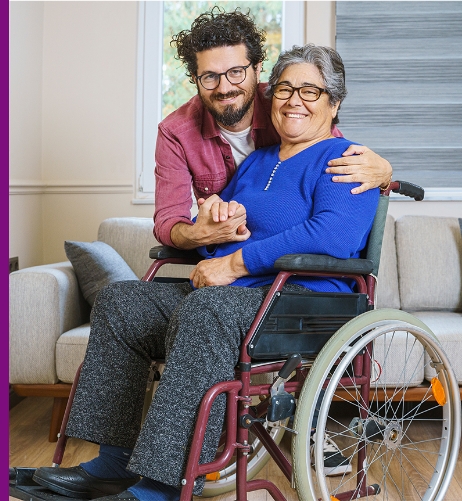Planning your estate: Start with the essentials
If you’re enrolled in the voluntary legal insurance plan through Sandia Extras, you have access to no-cost estate planning services through ARAG. Alternatively, explore the resources available through your Employee Assistance Program (EAP) benefits. To learn more, visit hr.sandia.gov. You can also connect with a Wellthy care coordinator to learn about legal and financial resources they offer.
Fidelity offers a wealth of resources to help you create your estate plan.
More smart money moves
Find long-term care (and more) through Wellthy
 Life usually hums along as planned until you encounter something unexpected, like needing to find and set up ongoing care for yourself or a loved one. This could feel overwhelming if you had to figure it all out yourself. Fortunately, Wellthy has you covered (at no cost to you).
Life usually hums along as planned until you encounter something unexpected, like needing to find and set up ongoing care for yourself or a loved one. This could feel overwhelming if you had to figure it all out yourself. Fortunately, Wellthy has you covered (at no cost to you).
Wellthy can help you and your family tackle the logistical and administrative challenges of caring for yourself and your loved ones. Services include assistance for parents and caregivers, help finding providers and medical treatment options, support for medical insurance and financial assistance issues, and help finding emotional health and addiction assistance.
After you register with Wellthy, you’ll be matched with a care coordinator who will help you address the medical, financial, in-home, housing, legal, and/or social and emotional challenges you’re facing. Your care coordinator will help you prioritize tasks and, when possible, complete them on your behalf.
You and your family can use the Wellthy dashboard to stay current on appointments, contacts, tasks, conversations and documents. The dashboard serves as a hub that includes the care plan, messaging options, a shared calendar and documents, and medications and contacts.
It’s easy to get started. Sign up with Wellthy, and then create your account.
Protect your loved ones
 Who will receive your life insurance, retirement savings and Health Savings Account balance upon your death? How these assets are distributed is entirely up to you, which is why it’s so important that you name your beneficiaries for each of your accounts and keep them up to date as life changes. Getting married or divorced, having a baby, or losing a loved one can change what you want to happen to your benefits.
Who will receive your life insurance, retirement savings and Health Savings Account balance upon your death? How these assets are distributed is entirely up to you, which is why it’s so important that you name your beneficiaries for each of your accounts and keep them up to date as life changes. Getting married or divorced, having a baby, or losing a loved one can change what you want to happen to your benefits.
Your beneficiary is the person (or people) or trust that you name to receive a benefit when you die. You can name a single person, or you can have your benefits divided among multiple people. You can elect different beneficiaries for each account. You also have the option to choose secondary or contingent beneficiaries — people who will receive your benefits if your primary beneficiary dies — or you can name a trust as your primary or secondary beneficiary.
To ensure your benefits go to the intended people, visit the websites below and update your beneficiary information:
- Prudential: Sandia-provided life insurance
- Sandia Extras: voluntary life insurance
- Fidelity: 401(k) plan
- Optum: Health Savings Account (HSA)
And don’t forget to update beneficiary information for any life insurance policies and retirement and investment accounts you have outside of Sandia.
Make 401(k) catch-up contributions if you’re age 50 or older
 The IRS allows individuals ages 50 and older to make “catch-up” contributions to their 401(k). You can contribute $8,000 above the annual IRS contribution limit ($24,500 in 2026), for a total of $32,500. If you’re age 60-63, you can make a special catch-up contribution up to $11,250.
The IRS allows individuals ages 50 and older to make “catch-up” contributions to their 401(k). You can contribute $8,000 above the annual IRS contribution limit ($24,500 in 2026), for a total of $32,500. If you’re age 60-63, you can make a special catch-up contribution up to $11,250.
Why make catch-up contributions? Adding money to your 401(k) increases your interest-earning balance. The financial impact of compounded interest on catch-up contributions can help you retire when and how you want to. This is especially important if you’ve only started to prepare for retirement when you’re in your 50s. Your catch-up contributions will also reduce your taxable income.
Beginning in 2026, if you are age 50 or older and earned more than $150,000 in 2025, you must make any catch-up contributions on a Roth (after-tax) basis.
Your 401(k) contributions, along with the match from Sandia, cannot exceed $72,000 in 2026.
